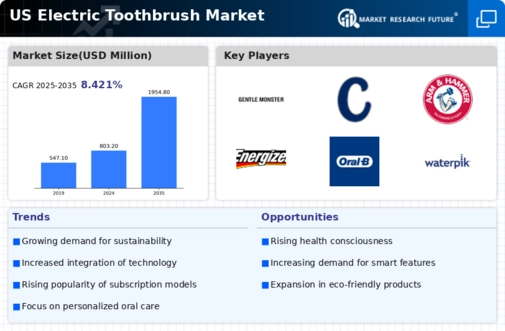Aging Population
The aging population in the United States is a crucial driver for the electric toothbrush market. As individuals age, they often face increased dental health challenges, making effective oral care more essential. Electric toothbrushes, with their advanced features, are particularly appealing to older adults who may have difficulty using manual brushes. The electric toothbrush market is likely to see a substantial increase in demand as this demographic grows. Projections indicate that by 2026, the market could expand by approximately 9% due to the rising number of older adults seeking products that enhance their oral hygiene routines. This demographic shift presents a significant opportunity for manufacturers to tailor their offerings to meet the needs of an aging population.
Rising Consumer Awareness
The electric toothbrush market is experiencing a notable surge in consumer awareness regarding oral hygiene. As individuals become increasingly informed about the benefits of effective dental care, the demand for electric toothbrushes is likely to rise. Studies indicate that consumers are more inclined to invest in products that promise superior cleaning capabilities. This trend is further supported by the proliferation of information available through various media channels, which emphasizes the advantages of electric toothbrushes over manual alternatives. In 2025, the market is projected to grow by approximately 8% annually, driven by this heightened awareness. The electric toothbrush market is thus positioned to capitalize on this trend, as consumers seek products that align with their health and wellness goals.
Technological Advancements
Technological advancements play a pivotal role in shaping the electric toothbrush market. Innovations such as smart connectivity, pressure sensors, and personalized brushing modes are becoming increasingly prevalent. These features not only enhance user experience but also improve oral health outcomes. For instance, smart toothbrushes that connect to mobile applications provide users with real-time feedback on their brushing habits, which can lead to better dental hygiene practices. The integration of artificial intelligence in toothbrush design is also gaining traction, potentially revolutionizing the way consumers approach oral care. As these technologies continue to evolve, the electric toothbrush market is likely to witness a significant uptick in demand, with projections indicating a market growth of around 10% by 2026.
Growing E-commerce Adoption
The electric toothbrush market is witnessing a transformation due to the growing adoption of e-commerce platforms. As consumers increasingly turn to online shopping for convenience and variety, the availability of electric toothbrushes through digital channels is expanding. This shift is particularly pronounced among younger demographics, who prefer the ease of purchasing health and wellness products online. E-commerce sales in the electric toothbrush market are projected to account for over 30% of total sales by 2026, reflecting a significant change in consumer purchasing behavior. Retailers are also enhancing their online presence, offering promotions and subscription services that cater to the evolving preferences of consumers.
Increased Focus on Preventive Healthcare
The electric toothbrush market is benefiting from a broader societal shift towards preventive healthcare. As healthcare costs continue to rise, consumers are increasingly prioritizing preventive measures to avoid more significant health issues down the line. This trend is particularly evident in oral health, where effective brushing is recognized as a critical component of overall well-being. The electric toothbrush market is poised to gain from this focus, as consumers seek tools that facilitate better oral hygiene practices. Market data suggests that the preventive healthcare approach could lead to a 7% increase in electric toothbrush sales over the next few years, as individuals invest in products that promise long-term health benefits.
























Leave a Comment